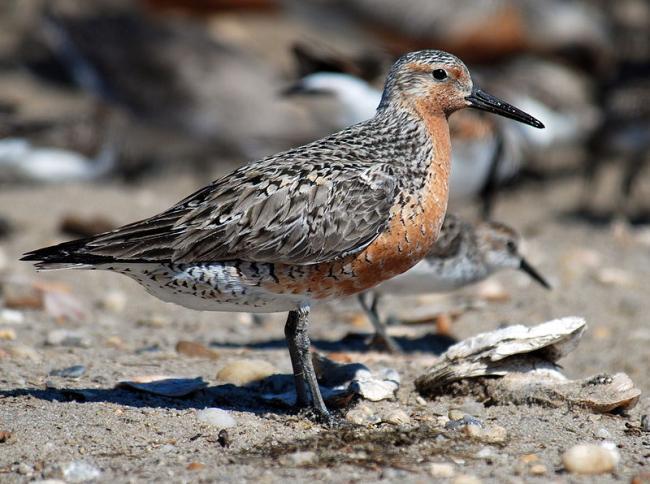Colours
Distinguishing features
The body shape is typical for the genus, with a small head and eyes, a short neck and a slightly tapering bill that is no longer than its head.
It has short dark legs and a medium thin dark bill. The winter, or basic, plumage becomes uniformly pale grey, and is similar between the sexes. The alternate, or breeding, plumage is mottled grey on top with a cinnamon face, throat and breast and light-coloured rear belly. The alternate plumage of females is similar to that of the male except it is slightly lighter and the eye-line is less distinct. canutus, islandica and piersmai are the "darker" subspecies.
Subspecies rogersi has a lighter belly than either roselaari or piersmai, and rufa is the lightest in overall plumage. The transition from alternate to basic plumages begins at the breeding site but is most pronounced during the southwards migration. The molt to alternate plumage begins just prior to the northwards migration to the breeding grounds, but is mostly during the migration period.
The large size, white wing bar and grey rump and tail make it easy to identify in flight. When feeding the short dark green legs give it a characteristic 'low-slung' appearance.
Juvenile birds have distinctive submarginal lines and brown coverts during the first year. In the breeding season the males can be separated with difficulty based on the more even shade of the red underparts that extend towards the rear of the belly. (Wikipedia)
Size
- From 23 cm to 26 cm (Length of specimen)
Wingspan
- From 47 cm to 53 cm
Synonyms
Similar taxa
-
Animalia:
Great Knot (species: Calidris (Calidris) tenuirostris)
The Great Knot is closely related to the more widespread Red Knot. In breeding plumage, the latter has a distinctive red face, throat and breast. In other plumages, the Great Knot can be identified by its larger size, longer bill, deeper chest, and the more streaked upperparts. (Wikipedia)
Distribution
Distribution and habitat preferences
North American breeders migrate to coastal areas in Europe and South America, while the Eurasian populations winter in Africa, Papua New Guinea, Australia and New Zealand. This species forms enormous flocks when not breeding. (Wikipedia)
Local abundance
- Lizard Island, Queensland, Australia: Domm (1977) records the Red Knot at Eagle Island but not Lizard Island between 1973 and 1976. He notes that less than 10 birds at a time were seen in summer at Eagle Island. Smith (1987) also records the species as a regular visitor to Eagle Island during the period 1983 to 1986, noting up to 33 individuals. The single record from Lizard Island is from 1 March 1977, by Queensland Department of Resources and Land Management (Atlas of Living Australia, 25 March 2012).
Audio recordings
Song from a bird on the ground in response to playback. The bird gave the whistled portions of the song while perched, and the chattering portions in short flight low over the ground. Habitat was a barren gravel covered hill surrounded by dry tundra.
© Andrew Spencer
(source)
Diet
Their diet varies according to season; arthropods and larvae are the preferred food items at the breeding grounds, while various hard-shelled molluscs are consumed at other feeding sites at other times. (Wikipedia)
Web resources
References
- Domm, S. (1977). Sea birds and waders of the Lizard Island area, The Sunbird, 8: 1-8. LIRS catalog number 4.
- Simpson, K., N. Day and P. Trusler (2004). Field Guide to Birds of Australia: 7th Edition Penguin Group (Australia), Camberwell, Victoria.
- Smith, G.C. (1987). The birds of Eagle Island, a tropical sand cay on the northern Great Barrier Reef, Australia, The Sunbird, 17(1): 1-11. LIRS catalog number 245.


